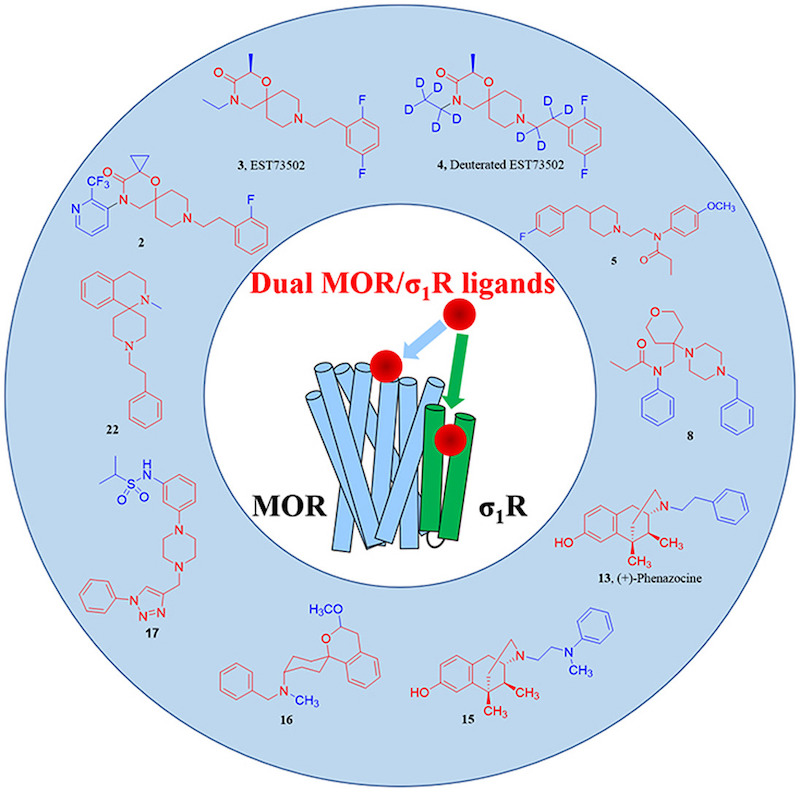Bifunctional μ opioid and σ1 receptor ligands as novel analgesics with reduced side effects
By Tao Zhuang, Jiaying Xiong, Shuaishuai Hao, Wei Du, Zhenming Liu, Bifeng Liu, Guisen Zhang, and Yin Chen
Introduction to the article published in European Journal of Medicinal Chemistry, Volume 223, 2021. Doi: https://doi.org/10.1016/j.ejmech.2021.113658
Editor’s Highlights
- Pain is undoubtedly both a major clinical and economic problem, affecting approximately 20% of the adult population worldwide.
- There is an unsatisfied need for the development of novel potent analgesics free of m opioid receptor (MOR) mediated unwanted adverse effects.
- The sigma-1 receptor (s1R), a unique Ca2þ-sensing chaperone protein with no homology to any known mammalian proteins, is expressed in key areas responsible for pain control.
The s1R can interact with various molecular targets to affect their functions, including several transmembrane G protein-coupled receptors (GPCRs) such as the m opioid receptor (MOR), k opioid receptor (KOR) and cannabinoid 1 receptor (CB1R) [8,12], and ion channels such as the N-methyl-D-aspartate receptor (NMDAR). - Unlike MOR agonists, s1R antagonists do not alter normal sensory thresholds under physiological conditions but decrease the sensory gain (allodynia or hyperalgesia) that occurs due to sensitisation of the nociceptive system in pathological states.
- The potentiation of opioid anti-nociception by s1R inhibition is not followed by the worsening of opioid-related unwanted effects including tolerance, addiction or constipation, so the concomitant administration of s1R antagonists may improve the therapeutic window of existing opioids.
- Bifunctional s1R antagonist and MOR agonist ligands (e.g. ADV502) have potent analgesic effects in acute and chronic pain models with fewer opioid-mediated relevant deleterious effects such as constipation and addiction.
- Dual MOR agonism/s1R antagonism represents an emerging and prospective avenue for the development of more potent and safer analgesics.
Autors’ Highlights
- σ1R antagonists exhibit anti-hypersensitive effects in sensitising pain conditions.
- σ1R antagonists enhance opioid analgesia but not opioid-mediated unwanted effects.
- Bifunctional MOR and σ1R ligands possess wider therapeutic window with fewer adverse effects.
- Representative ligands with MOR agonist and σ1R antagonist activities were summarised.
- Dual MOR-agonism/σ1R-antagonism represents a promising avenue for the development of potent and safer analgesics.
Abstract
Opioid analgesics are highly effective painkillers for the treatment of moderate or severe pain, but they are associated with a number of undesirable adverse effects, including the development of tolerance, addiction, constipation and life-threatening respiratory depression. The development of new and safer analgesics with innovative mechanisms of action, which can enhance the efficacy in comparison to available treatments and reduce their side effects, is urgently needed. The sigma-1 receptor (σ1R), a unique Ca2+-sensing chaperone protein, is expressed throughout pain-modulating tissues and affects neurotransmission by interacting with different protein partners, including molecular targets that participate in nociceptive signalling, such as the μ-opioid receptor (MOR), N-methyl-d-aspartate receptor (NMDAR) and cannabinoid 1 receptor (CB1R). Overwhelming pharmacological and genetic evidence indicates that σ1R antagonists induce anti-hypersensitive effects in sensitising pain conditions (e.g. chemically induced, inflammatory and neuropathic pain) and enhance opioid analgesia but not opioid-mediated detrimental effects. It has been suggested that balanced modulation of MORs and σ1Rs may improve both the therapeutic efficacy and safety of opioids. This review summarises the functional profiles of ligands with mixed MOR agonist and σ1R antagonist activities and highlights their therapeutic potentials for pain management. Dual MOR agonism/σ1R antagonism represents a promising avenue for the development of potent and safer analgesics.
Graphical abstract


